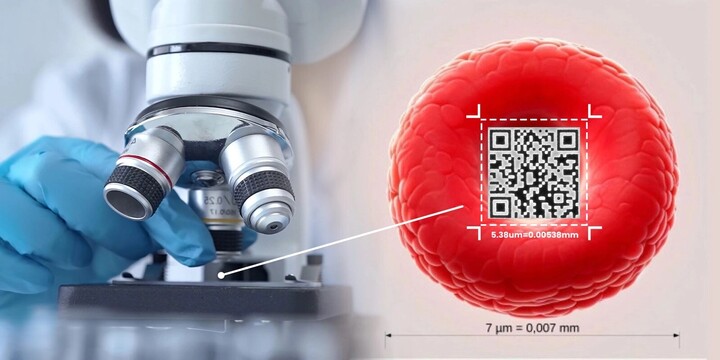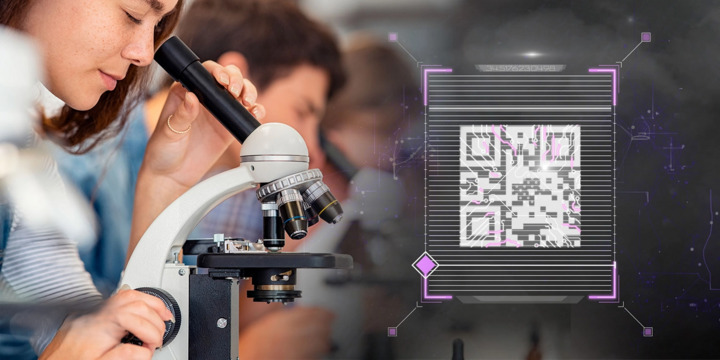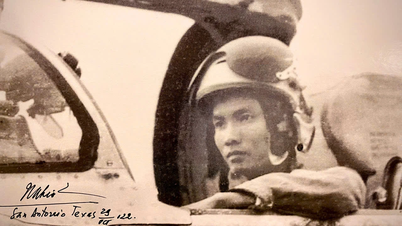The University of Münster currently holds the record for the smallest readable QR code, measuring just 5.38 square micrometers – an incredible feat of nanotechnology.

The world's smallest QR code is designed. (Source: QRTiger)
To put that into perspective, this QR code is seven times smaller than a human red blood cell! You’d need a powerful microscope to find it – and even then, finding it is a “needle in a haystack” challenge.
Typically, the minimum size of a QR code that most smartphones can scan is 1x1 cm. However, the recommended size is 2x2 cm to ensure accurate scanning.
In digital environments, the standard size of QR codes usually starts from 250x250 pixels to ensure scanning accuracy.
The previous record holder – a QR code from Singapore – was much larger, so the new German-made code has earned the title of “ small but mighty” .
Built using cutting-edge nanotechniques from the university's Department of Quantum Technologies, the achievement shows that quantum physics isn't just for supercomputers or sci-fi movies – it's also creating practical applications like QR codes!
An interesting comparison: If you were to scale a human hair to the size of a football field, this QR code would be smaller than a coin placed on that field.
The Power of Quantum Physics
The world's smallest QR code isn't just a record-breaker – it's also a tiny masterpiece that demonstrates the incredible possibilities when science and technology come together.
This achievement highlights the creative potential of physics, inspiring students to explore how it connects to real life. If quantum physics can shrink a QR code to the size of a red blood cell, surely it can bring many more surprises.
More practically, this feat of precision could lead to breakthroughs in computing, communications, and even the science fiction futures we dream of.
As Professor Schuck of the University of Münster puts it, this is not just a scientific demonstration – it is also a challenge to future physicists: Break even smaller records.

The advent of the micro QR code signals an important step forward. (Source: QRTiger)
Small code, big impact
A new achievement from the University of Münster shows that QR codes – a familiar tool in everyday life – still have much more potential to develop than we once imagined. Measuring just 5.38 square micrometers, this ultra-small QR code not only sets a world record but also opens up new directions for applications in the fields of security and nanotechnology.
According to the research team, QR codes can be miniaturized to the point where they can be integrated into microscopic materials such as dust particles. This is especially useful for tracking goods, authenticating products, or protecting high-value items that cannot be detected by the naked eye.
In the medical field, this technology also opens up the possibility of tagging micro medical devices or supporting personalized treatments, tailored to each patient.

Scannable QR codes or barcodes could help people with dementia find their way home. (Source: AFP)
The miniaturization of QR codes to microscopic sizes demonstrates the flexibility and adaptability of this technology. This is also the motivation for developers to continue improving QR code generators, aiming for more compact versions that still ensure the ability to store and transmit data effectively.
As QR codes play an increasingly important role in areas such as electronic payments, smart urban management, and traceability, breakthroughs like these could reshape the way we view and apply identification technology in the future.
This world record is not only a remarkable technical achievement, but also a testament to the potential practical applications of advanced research in quantum physics and nanotechnology.
Source: https://vtcnews.vn/cac-nha-vat-ly-pha-ky-luc-voi-ma-qr-nho-nhat-the-gioi-ar960583.html






















![[Photo] General Secretary To Lam attends the inauguration and groundbreaking ceremony of 250 projects to celebrate National Day](https://vphoto.vietnam.vn/thumb/1200x675/vietnam/resource/IMAGE/2025/8/19/3aa7478438a8470e9c63f4951a16248b)


![[Photo] Close-up of the first International Financial Center building in Ho Chi Minh City](https://vphoto.vietnam.vn/thumb/1200x675/vietnam/resource/IMAGE/2025/8/19/3f06082e1b534742a13b7029b76c69b6)
![[Photo] President Luong Cuong's wife and Queen of Bhutan visit Tran Quoc Pagoda](https://vphoto.vietnam.vn/thumb/1200x675/vietnam/resource/IMAGE/2025/8/19/62696af3852a44c8823ec52b03c3beb0)
![[Photo] General Secretary To Lam and President Luong Cuong attend the handover ceremony of the Presidential Office Headquarters](https://vphoto.vietnam.vn/thumb/1200x675/vietnam/resource/IMAGE/2025/8/19/a37cfcbd301e491990dec9b99eda1c99)


![[Photo] General Secretary and Prime Minister visit the National Exhibition and Fair Center](https://vphoto.vietnam.vn/thumb/1200x675/vietnam/resource/IMAGE/2025/8/19/f4503ad032d24a90beb39eb71c2a583f)





































































Comment (0)